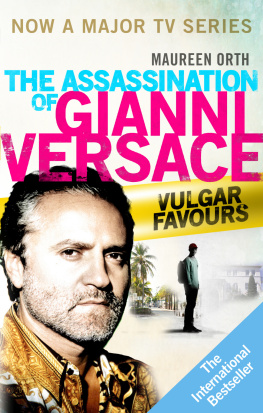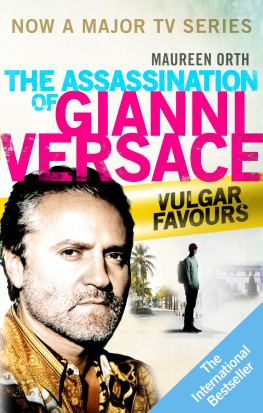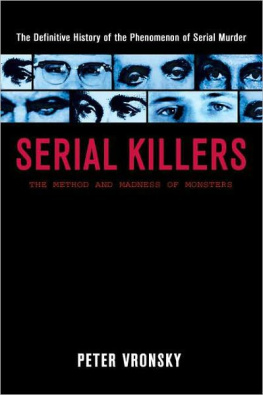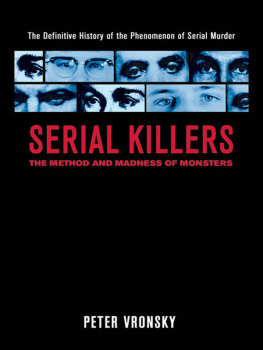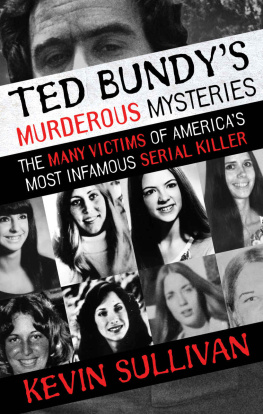CONTENTS
About the Book
On 15 July 1997, Gianni Versace was shot dead on the steps of his Miami Beach mansion. Within hours, the police had identified his murderer as Andrew Cunanan, a serial killer on the FBIs Most Wanted list.
At the time of Versaces murder, award-winning journalist Maureen Orth was already investigating Cunanans killing spree for Vanity Fair. Drawing on over 400 interviews and thousands of pages of police reports, she reveals the story of what led Cunanan to become one of Americas most notorious serial killers, and how he managed to elude the police and FBI for so long.
The basis for the new drama series The Assassination of Gianni Versace, this is a riveting account of a sociopath, his savage crimes, and the mysteries he left along the way.
About the Author
Maureen Orths award-winning career began as one of the first women writers at Newsweek. Currently a Special Correspondent for Vanity Fair, she has profiled everyone from Margaret Thatcher and Angela Merkel to Bruce Springsteen and Taylor Swift, and has researched and written groundbreaking pieces on Woody Allen and Michael Jackson, among others. Her far-ranging work not only includes the investigation of serial killer Andrew Cunanan and of pedophile priests but a best-selling cover story for National Geographic on the Virgin Mary.
For Tim and for Luke and for my mother, who told me, Any damn fool can write a book.
Just look at the vulgar favors that give the crowds of the capital such delight Its amusements are insolent, obscene, clumsy and boorish You despise these lewd doings and yet you suffer them.
from the Richard Strauss opera Capriccio
Prologue
THE PHONE RANG about 1 A.M. , and my husband sleepily caught the receiver.
Is Maureen Orth there? Is this Maureen Orth, the writer? The male voice was insistent.
Whos this?
I want to discuss the article. A pause, then a click.
It sounds like him, my husband told me.
Who?
The guy youre writing about.
What? You mean Andrew Cunanan?
Weird, my husband said. Then he flopped over and went back to sleep. But by then I was wide awake.
About ten days later, hours after Gianni Versace, the famed fashion designer and gay icon, was murdered, the phone rang again a little after 1 A.M. I was already booked on a morning plane to Miami to report the breaking story of Versaces murder, because the number-one suspect was Andrew Cunanan. By then I had been reporting on Cunanan for nearly two months for Vanity Fair magazinehis favorite publication. I also had learned that he had met Versace several years earlier and that he was suspected of killing four other people, including his best friend and the only man he ever said he loved.
Hello. Is Maureen Orth there? My husband recognized the same gay male voice. Whos calling? But the person on the other end thought better of it. The long-distance background sound cut off abruptly. I will never know if I thereby lost the scoop of my life.
Under any other circumstances, appearing in Vanity Fair would have been Andrew Cunanans dream come true. By then, however, in early July 1997, he was about to become the subject of one of the largest manhunts in FBI history. Thousands of people would be looking for him, yet nobody knew where he was.
Nine days later, Andrew Cunanans body was found on what would become an infamous Miami Beach houseboat. Moreover, the aftermath of his crimes and his cruel and tragic journey through America would reverberate for months. What began in the media misleadingly as a gay lovers quarrel, confined to a closed but out gay world, built as Cunanans murders became more heinous and bold into a story that catapulted him to the forefront of the mainstream pressleading the evening news, on the cover of both Time and Newsweek. But before Andrew Cunanan killed Gianni Versace and gained worldwide notoriety, he had already traversed a gay parallel universe in America todaytraveling from the seamy, drug-addled underbelly of the demimonde to the cultured and privileged world of the rich and the closeted.
Andrew fit in anywhere. He could discourse about art and architecture, and he was a walking encyclopedia of labels and status. As a kept boy, he got all the way to the Gritti Palace in Venice and a house on Cap-Ferrat. But then he fell in love with a hardworking young architect andostensibly because the rich older man who paid his way wouldnt give him the model Mercedes he wantedhe walked out of the pampered world to which hed always aspired.
No matter how much Andrew Cunanan got, he always wanted moremore drugs, kinkier sex, better wine. Somehow he had come to believe that they were his due. And why not? He was always the life of the party, the smartest boy at the table. But at twenty-seven he was also a narcissistic nightmare of vainglorious self-absorption, a practiced pathological liar who created alternate realities for himself and was clever enough to pull off his deceptions. In the trusting or superficial circles in which he traveled, Andrew made himself indispensable. Lurking just beneath the charm, however, a sinister psychosis was brewing, aided by Andrews habits of watching violent pornography and ingesting crystal meth, cocaine, and various other drugs so prevalent in some circles of gay life todaybut not spoken of. Anyone who has done crystal and been on a bad streak can look at this whole thing [and understand], says Joe Sullivan, a former crystal-meth user who knew Andrew in San Diego. I cannot believe not one person has associated a crystal freakout with this.
As I reported Andrew Cunanans story, it was up to me to try to unravel the lies and untangle the contradictionshe did not yield his secrets easily. He began life as a beautiful child of mixed Filipino and Italian heritage with an IQ of 147. But his parents had a desperately unhappy marriage, and they counted on their youngest child to save and validate them. Under tremendous pressure from them, the gifted little boy was never able to form a coherent adult personality. The more I learned about him, the sadder it was to see how drugs and illicit sex increasingly coarsened his instincts, how prostitution on many levels eventually left him lazy and unprepared. When the jig was up, he had no professional or moral resources to fall back on. He had been seduced himself by a greedy, callous, and pornographic world that proffered the superficial values of youth, beauty, and money as the maximum attainments of a happy life. In the end Andrew Cunanan, so witty and quick, the product of a fanatically Catholic mother and a just as fanatically materialistic father, gave in to his mean darkness and inflicted incalculable pain on others.
In following the skewed path of Andrew Cunanan, I became fascinated with the idea that I was not merely reporting about a warped young man and his bloody violence. I, too, was making an offbeat odyssey through end-of-the-century America, where new communities had formed in the last two decades, where political correctness in the melt-resistant melting pot paralyzed many aspects of law enforcement and the media, where money papered over a lot of lapses. Some things, of course, are eternal, such as the ability of powerful families to block exposition of the truth and to keep their secrets hidden.

